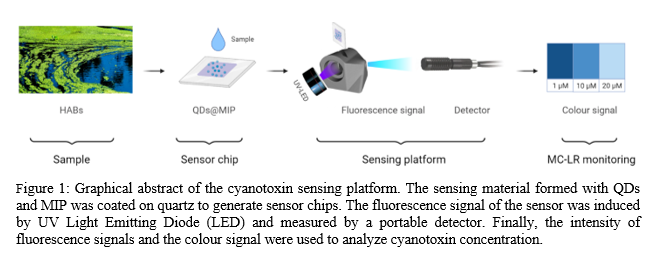DETECTION OF CYANOTOXIN MICROCYSTIN-LR (MC-LR) WITH PORTABLE OPTICAL SENSOR
Harmful algae blooms (HABs) are excessive growth of certain types of algae or cyanobacteria that cause grave danger to humans, wildlife, and the ecosystem. HABs are also an increasing threat to aquaculture not only by reducing dissolved oxygen but also by poisoning fish species with their secondary metabolites cyanotoxins. The acute toxicity of these secondary metabolites is triggering mass mortality in various fish species and harvesting bans on toxin accumulated shellfish. The economic loss due to HABs in aquaculture is reaching a few billion dollars per year globally. Moreover, the incapability of the current algae detecting microscopic method to recognize cyanotoxins is enhancing their adverse health and economic impact.
Our research has focused on the development of portable sensors that can deliver real-time, accurate information on cyanotoxin concentration. The sensor consists of three main components: a recognition unit, a response unit and a detection unit. The recognition unit is made of a synthetic receptor molecularly imprinted polymer (MIP) that provides high target selectivity and long-term stability; the sensing unit is comprised of fluorescent material quantum dots (QDs) that offer high sensitivity and visualizable sensor signal; the detection unit consists of a simple light detector that imparts sensor with portability. In the first stage, the sensor was tested using model cyanotoxin microcystin-LR (MC-LR). The sensor was able to show an increasing sensor response to elevating MC-LR concentration, high selectivity against other common chemicals in water and a limit of detection of 1 µg/L.
On account of the synthetic nature of the MIP receptor and the wide-range applicability of the fluorescence materials, the developed sensing materials can be easily modified to detect other families of cyanotoxins to offer comprehensive monitoring of HABs. Therefore, the development of this sensor provides a fast and cost-effective method of monitoring cyanotoxin in real-time and a chance to take immediate action to mitigate the effect of HABs on aquaculture.
